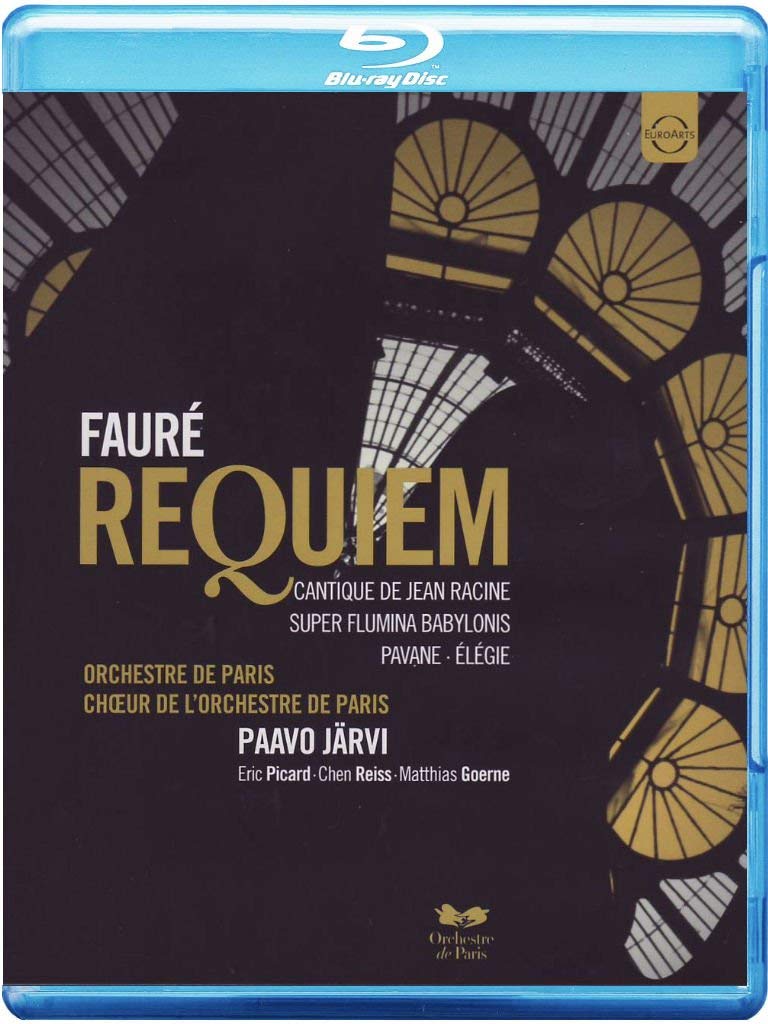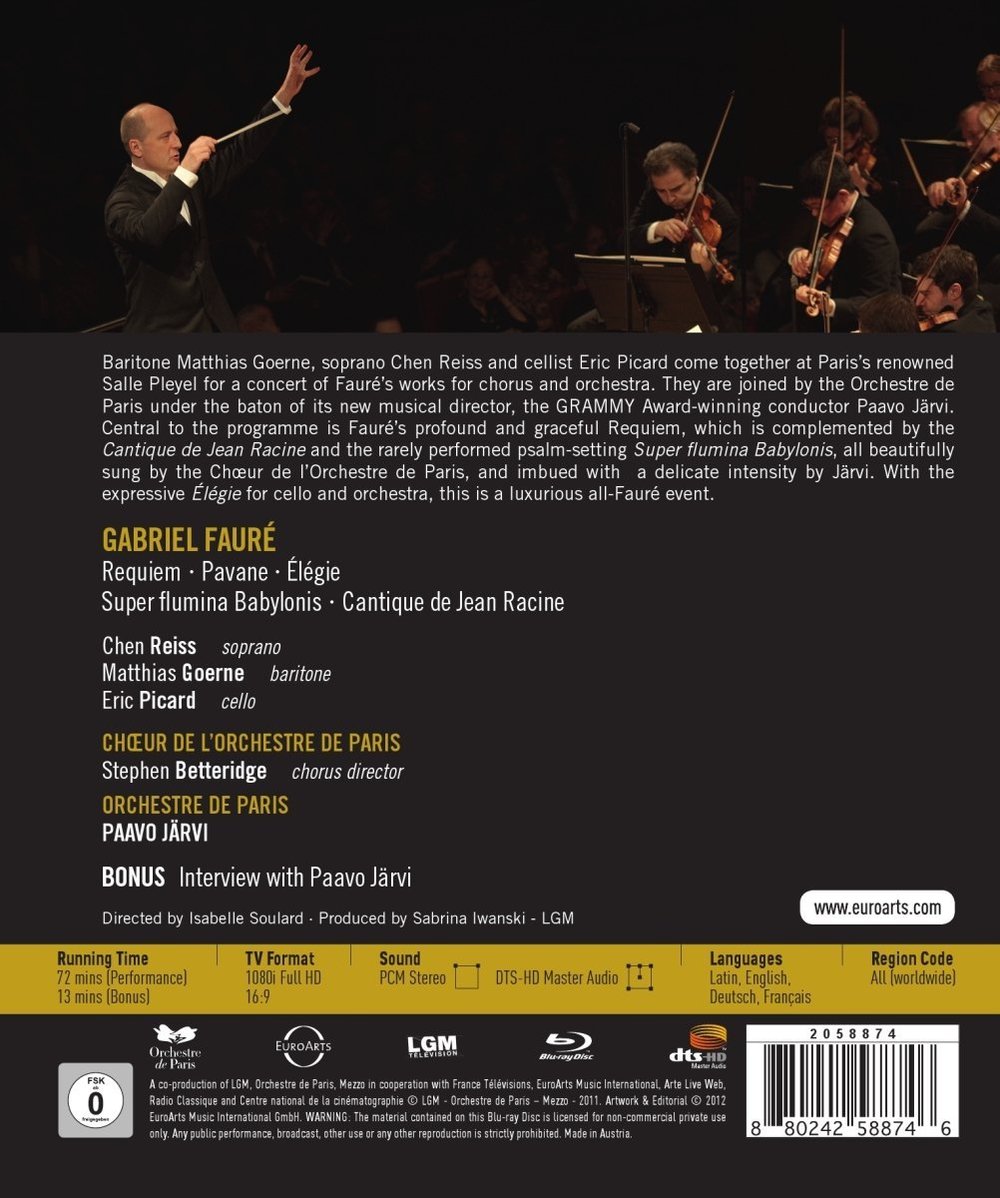

Fauré Requiem concert. Performed 2011 at the Salle Pleyel in Paris. Features the following pieces by Fauré for orchestra and chorus:
Pavane in F sharp minor, Op. 50 [6:44] (Popular piece based on a Spanish dance called the pavane)
Élégie in C minor, Op. 24 [7:23] (cello Eric Picard) (chorus rests)
Super flumina Babylonis [11:00] ("By the rivers of Babylon")
Cantique de Jean Racine in D flat major, Op. 11 [6:08] ("Hymn of Racine")
Requiem in D minor, Op. 48 [37:30] (soprano Chen Reiss and baritone Matthias Goerne)
Paavo Järvi conducts the Orchestre de Paris and the Chœur de l'Orchestre de Paris (Chorus Director Stephen Betteridge). Directed for TV by Isabelle Soulard; film edited by Richard Poisson; audio by Aurélie Messonnier; produced by Sabrina Iwanski. Released 2012, disc has 5.1 dts-HD Master Audio sound. Grade: C
General Comments
All the music on this disc, while modern enough to be relevant today, is melodic and relaxing to the point of being blissful. Most of the selections are religious, but there's nothing pompous, imposing, or sanctimonious about them. The orchestra and singers were fine, and I'm sure the audience heard a grand performance. The more I listened to this disc, the more I liked it; and I'm grateful for this introduction to Fauré, a composer that was new to me. But I still have plenty of criticism as to how the disc could have been better made.
PQ is weak throughout. As you can see from the screenshots below, the lighting on the Pleyel stage was spotty and probably low. I also question whether Soulard had adequate video cameras. On my 59" calibrated plasma display the image has soft resolution (somewhere between HD and SD) and looks hazy. There is glare from the sheet music and skin tones are often pink. Wonk Gordon Smith, who uses a projector, reports that "the lighting is terrible [and] washes out the image . . . killing any contrast." I found that the poor PQ didn't in itself keep me from admiring the beauty of the performance, but it's not what we expert in a full-priced HDVD.
SQ also falls short. Generally the sound is enjoyable, and I heard considerable dynamic contrast on my system. The devil pops up in the details. There's a lot of pizzicato in Fauré's music. I could see the strings being plucked and I could hear them, but only faintly and without verve. I could hear the harp, but not well; I doubt the harp had its own mike.
Gordon Smith often watches symphony HDVDs with headphones and stereo sound. He reports that the left and right channels in stereo are incorrectly reversed. So when the soprano (in the Requiem) stands on the left side of the the stage as seen by the viewer, the sound of her voice comes from the right earphone. I was not able to duplicate this in my small HT, which doesn't have a center speaker. On my system, the voice of the soprano in the Requiem seems to come from the center. Also, I point out that Gordon has no problem with the surround sound.
Requiem
The Requiem recording has an acute case of DVDitis. See our special article on this dread disease for more about the cause and symptoms of DVDitis. I ran the numbers. The Requiem lasts 37.5 minutes and has at least 300 cuts. That's 7.5 seconds for the average cut. This is too fast for a short piece of serene music. The very fastest recordings I have measured have cuts that average about 5 seconds. The best symphony HDVDs have cuts that average 15+ seconds each.
The good symphony HDVD will proceed at a stately pace to show the viewer plenty of whole-orchestra shots as well as shots of whole sections and multiple sections. Featured soloists will, of course, receive special attention. This will be augmented with a modest number of shots of first-chair soloists and the conductor. The idea is to start the viewer off with a show similar to what he would experience at a live concert, and then add value through close-up shots that the spectator at the live performance can't see.
Soulard and Poisson give us not even one whole-orchestra shot from the Requiem. At 00:37:33 there is a single shot that embraces the whole orchestra, but it doesn't count because the angle hides many of the musicians:
The picture above shows that the orchestra is placed on the stage off-center to the right (there are 2 ranks of double basses on the right that are not balanced off on the left). The shot below shows that the chorus was placed on the stage off-center to the left. All this imbalance may have made it harder to get good whole-orchestra shots:
There are several whole-orchestra shots like the one below. A double bass is missing, but this is close enough to be counted as a WO view. With this picture, you can see where all the musicians are located:
In all the pictures above, some of the singers in the chorus are in a shadow. In the view below, the entire chorus recedes into gloom. Did someone turn the lights off in the middle of the show? I don't think so. Maybe this is some kind of gross camera error:
Here's a shot showing the chorus as a section and the lighting over the stage. I'm not versed in stage lighting, but common sense tells me the lighting here is flimsy:
To be fair, there are about a dozen shots of most of the orchestra (and typically the entire chorus), but even these tend to be cut short.
The cameramen were instructed to pan and zoom at will—little is allowed to stay still long. I work so hard adjusting to the "performance" of the cameras that I have less energy left with which to enjoy the actual performance. I should feel uplifted by the beautiful music on the disc; but to some extent, I feel drained at the end from squandering energy on the antics of the videographers.
The video team shows almost no interest in the various sections of the orchestra—I count only 3 good shots featuring whole sections and 1 decent multi-section shot. There were several attempts to show violins as a section as you see in the next streenshot. But these are weak because the cameramen used the wrong angle. A shot of a string section should show the faces of the instruments and should not show the backs of the instruments and backs of players:
So far above I counted 15 goods shots. To these I add 7 shots that fill the screen with the entire chorus (the chorus viewed as a section). So of the 300 clips in the video, only about 22 take full advantage of HDVD capabilities. Everything else is pure DVDville.
Of the 278 DVD-style shots, the content quality is low. The biggest problem are the lazy shots. These include 59 shots of the front of the conductor and 20 shots of the conductor made over the backs of the musicians. There are 25 shots mostly wasted on showing instruments only. Finally, there are 67 shots showing one individual or a small group of the chorus singing. What a picnic at the zoo—point your camera anywhere in the chorus and you get a shot!
The rest of the clips are standard DVD fare of individuals or small groups of players in the orchestra. In the Requiem, the cameramen could not get a decent shot of the 4 horns. Here we see 4 instruments, but one player is missing and two others are our of focus:
The next shot of the horns is even more pitiful:
What was this shot supposed to be?
Even soloists Chen Reiss and Matthias Goerne are abused by mixing too many weak clips in with their elegant contributions. Everyone agrees that Reiss was sublime in her short solo of 3 minutes and 20 seconds. There should have been one camera locked on her for the this entire time. When she was singing, nobody in the audience looked at anything but her. But alas. Here's what happens to her solo (each slash is a video cut): Reiss with conductor/Reiss/conductor/Reiss/Reiss with conductor/2 flutes/Reiss/Reiss/Reiss/Reiss/conductor/single violin/Reiss/Reass with conductor/Reiss/conductor/Reiss/instrument only/conductor/Reiss/conductor/pan through orchestra/Reiss/Reiss with conductor/woodwinds/Reiss/Reiss with conductor. So there were 27 cuts in 200 seconds for the same fast-paced 7.5 seconds per clip we noted earlier. And fewer than half the shots show Reiss alone. This is DVDitis compounded by an acute case of adult attention deficit disorder!
Video content is also plagued with framing and focus technical errors. Nobody should do this to a pretty woman:
Here's a shot of a whole row of men in the chorus, but only one is in focus:
Next a shot with nothing in focus other than the scroll of a cello:
Finally, here are a few examples of inane instrument-only shots that should have been edited out (there are others):
Four Shorter Pieces
The program opens with the Pavane. The TV director fails to perform her first task, which is to give the viewer shots of the whole orchestra long enough for the viewer to see where all the instruments are located. The next picture is one of 3 shots in the Pavane showing the whole chorus and 95% of the orchestra. But each of these shots is cut too short for the viewer to absorb what he's seeing:
There are 66 cuts in the Pavane that average about 6 seconds. So we have an even faster DVD-style video that we noted in the Requiem. There is exactly one shot from the Pavane I admire as being worthy of an HDVD recording—it's a view of the entire cello section playing:
It would be nice to see the bassoons and the clarinets playing together. But the frame below is a mess—the shot should have been assigned to a camera closer to the center of the hall:
More inexplicable framing and focus errors:
This is the second clip in the opening of the concert. This was not an error. The cameraman deliberately went out of focus on everything other than double base scroll. It's insulting to the viewer and the orchestra players to pull stunts like this in a symphony concert:
The next shot is one of the last clips in the Pavane, and this time the flute player is out of focus and there is an out-of-focus bow in the foreground. When the pace of the shoot is too fast, the cameramen often don't have time to frame their images carefully and attend to all the details of getting a good picture:
So we conclude the Pavane is infected with DVDitis the same as the Requiem. The two other short titles are full of the same errors as the Pavane.
Summation and Grade
This program, with fine performances and conducting of glorious music, had the potential for an A+ grade. Weaknesses in PQ and SQ knock us down to a B. DVDitis gets us into C or D territory. Gordon Smith suggested that the mix-up in the stereo sound track should yield a final grade of D+. That would be the correct grade if you are a headphone user. I raise the grade overall to C because I think most HDVD fans use surround sound most of the time.
Why am I being so tough on this gentle recording? Well, if this were available at $15 and you would be happy with it as a DVD with improved resolution, it might be a reasonable purchase. But the mission of this website is to encourage the industry to produce good HDVDs for folks who appreciate the best. From that perspective, this Blu-ray is a big and sad missed opportunity.
OR





















